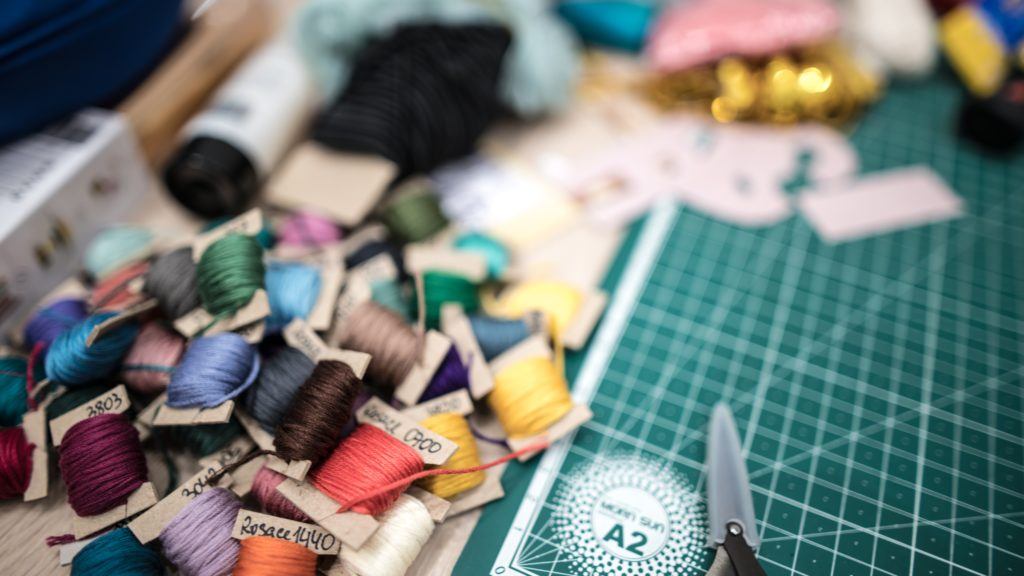Sewing is often seen as a labor of love. A great deal of time, care, and attention goes into every stitch, and the end result is well worth the effort devoted to each project. The same can also be said for teaching.
While they may seem vastly different on the surface, both sewing and teaching require a certain level of patience and nurturing that can easily transfer over to the other.

After all, what better way to spread your passion for sewing than by becoming a sewing teacher?
But how do you become a sewing teacher? What sort of credentials do you need? How would you go about starting up some sewing classes in your community?
As it turns out, you do not need a fancy sewing certificate or tailored training manual for teaching sewing! Here are just a few tips for ambitious sewers who want to try their hand at teaching their craft to others.
Sewing Teacher Qualifications
Unlike many occupations nowadays, you do not need a college degree to become a sewing teacher. A simple passion for sewing and a strong desire to infuse it in others will suffice.
It can be difficult to know where to begin, however. How do you gather students who are willing to pay to learn from you? Just what do you teach them, and how do you get them to stay?
Know the right ways to market your skills and how to teach a large group of potential students. These are skill sets that can be learned through trial-and-error, of course, but some prior training in teaching and marketing will help you tremendously.
You do not need to attend college to acquire these skills.
Teaching Programs
In fact, there are a good number of trained sewing instructor classes held in various cities around the country.
Palmer/Pletsch is a teaching company that specifically teaches others how to teach sewing.
They offer a series of teacher training classes that will not only provide you with the professional tools you will need to start your very own sewing classes, but they also connect you to a network of other sewing teachers and professionals worldwide.
You will have access to their other teacher training courses as well as all of their teacher resources, provided to you through their program.
Additionally, the Sewing & Craft Alliance of America hosts their very own Trained Sewing Instructor program, where they will provide you with business training that will help you and others interested in the sewing education industry thrive.
Many of their program’s graduates go on to start their own home-based businesses, teach in retail outlets, or start their very own sewing schools.
Degrees
For those who are interested in pursuing a higher education, you may want to try earning an associate’s degree in fashion design.
College classes expand on the condensed lessons you may have learned from the shorter training programs listed above. They may also teach you even more sewing techniques through a variety of lectures, personal projects, and possible internship opportunities.
Associate degrees normally take only two years to complete, and many colleges’ course schedules are very flexible.
You can attend night classes or weekend studies in between your current job and other obligations, or even choose to take a full online program, if that is what you prefer.
You may also choose to further your education and earn a bachelor’s degree in fashion design or fashion merchandising.

It is in these higher-division classes where you will be taught business management and other related skills, which not only prepare you for setting up your own sewing education business but will also introduce you to a variety of other outlets you can pursue to fulfill your sewing passion.
How to Teach Sewing Classes
Pricing
Teaching a sewing class is, first and foremost, a business. Your income as a sewing teacher will naturally come from your students. It’s necessary to set your rates to your liking.
A good starting tip is to try and match rates with other classes you see around town or online.
You may even choose to start up a YouTube channel or blog where you can teach basic sewing techniques, and then advertise your separate donation pages on Pateron or Ko-fi at the end of each video or post respectively.
Payment Methods
For the uninformed, Patreon and Ko-fi are sites where people who want to support your work can donate money to you for the content you produce online.
Basically, Patreon is a monthly donation subscription service, where your students can choose how much they want to pay you for your services per month, and you can even set up exclusive bonuses for patrons who choose to pay higher subscriptions.
The only drawback is that Patreon takes a small percentage of the donation money you earn, so it would be best to create one only after you are sure that you have a steady audience for your content.
Ko-fi is a more general donation service, where your students can donate as much as they want at any given time. While it does not offer tiered subscription bonuses as Patreon does, it does not take any fees that you earn. Once someone donates to you on your Ko-fi page, that money is yours.
Of course, these services provide less stability than setting a strict rate for your classes, so if you are not particularly Internet-savvy, then perhaps the traditional in-person route is the way to go.
Once you start to gain traction, you may then choose to increase your prices, or even to let your students start setting the prices they are willing to pay if they want to learn more from you.
This works best if you live in an area that is more underprivileged. This way, you are helping your potential students work around their budgets and learn new sewing techniques from you.
Of course, this means your income will be a little unpredictable, but you may earn glowing recommendations from former students that will help you gain an even greater following.
Lesson Plans
Of course, with whatever sewing class you choose to teach, you must have a lesson plan readily available. This means that you will have to plan out what to teach for however long your class will last.
Make sure you are as detailed as possible, both for yourself as the weeks go on and for any potential employers who may want to take a look at your plan as well.
Providing a lesson plan to your employers (if you choose to teach in areas outside of your home) will prove to them that you are capable of teaching others your craft in a respectable, professional fashion, and it provides them with an outlook of how your classes will generally go.
Finding a Locale
The best places to offer your services are typically fabric stores, community centers, or in local schools.
Fabric stores might be more inclined to hire you on as a teacher, as they have the opportunity to earn extra revenue from potential students you take on through the purchase of their fabrics or other products.
Community centers and schools may be a little more difficult to convince, but, again, this is where your lesson plan will help.

The Type of Class
You will then need to decide what type of sewing class you are willing to teach. Typically, beginners’ courses in sewing are the most popular, especially among children.
These beginner courses are the perfect opportunity to play the field and get a feel for what it is like to teach a class.
If you are feeling more confident, you may also want to begin teaching more advanced classes. This can include more advanced techniques, alterations, quilting, costume-making, or any other sewing project class you think you are able to teach.
Know Your Audience
Keep in mind the demographic you want to teach before starting up any kind of sewing class, too. Scheduling is key for this.
If you are interested in teaching ‘beginning sewing classes for children,’ it is best to work out some form of an after-school program or community class that children will have easy access to. Weekend or summer classes may also work out better for their schedules.
If you want to teach adults, no matter their experience level, it is best to schedule your classes in the morning. Typically, elderly adults, stay-at-home parents, or college students will attend at these times.
They will all come with varying levels of skill, so be prepared to help some students more than others.
Evening classes tend to be the most variable. Students are out of school at this point and adults will be done with work for the day.
You may just have a mix of the two demographics, but do not let this deter you from teaching during these hours. Your lesson plan should guide you on how to teach your classes, regardless of the age of your students.
Of course, if you still wish to teach a certain demographic, then feel free to suggest the age range that you are willing to teach, and your employers will keep this in mind.
Know Your Budget and Materials
Be sure to make a list of all the materials you will need, as well as what materials your students will need to bring for your classes.
Depending on your budget and the location where you choose to hold your classes, you may not have access to multiple sewing machines or supplies.
Be sure to come up with a comprehensive list that you will distribute to all your students, so they know what they should and should not bring.
Here’s a video showing some tips on how to teach sewing classes to kids.
Do you have any tips on how to become a sewing teacher?
